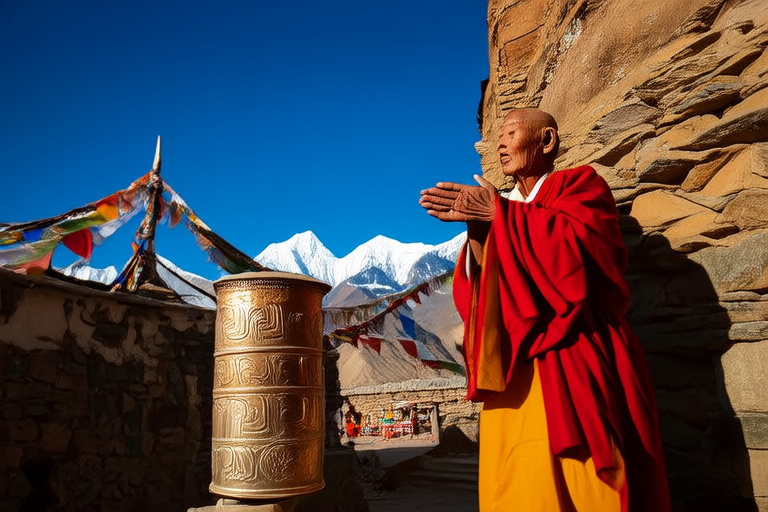The Whisper of Ancient Wisdom: Delving into Rich Cultural Customs

The Whisper of Ancient Wisdom: Delving into Rich Cultural Customs
Introduction
Ancient wisdom whispers through the annals of time, offering invaluable lessons and insights that continue to shape our world today. These age-old traditions and practices, deeply rooted in the fabric of human civilization, remind us of the rich tapestry of cultures that have thrived across continents. From the bustling streets of Asia to the serene landscapes of Africa, the vibrant hues of Latin America, and the historic towns of Europe, each region boasts unique customs and rituals that have been meticulously preserved over centuries.
The preservation of these cultural practices is not only essential for maintaining a connection to our past but also for enriching our present. As global interactions increase, it becomes crucial to understand and respect the diversity of cultural customs, ensuring that they remain integral parts of our shared human heritage. This article delves into the historical significance of various cultural practices and explores how they continue to influence modern society.
Roots of Ancient Wisdom
The origins of many cultural practices can be traced back to ancient civilizations, where traditions were born out of necessity, belief, and community bonding. These practices often serve as a testament to the resilience and ingenuity of early human societies.
In Asia, the Lunar New Year celebrations are a prime example of ancient wisdom being celebrated annually. Originating in China thousands of years ago, this festival symbolizes the arrival of spring and the hope for a prosperous year ahead. It is marked by vibrant parades, family gatherings, and the exchange of red envelopes filled with money. In India, Diwali, the Festival of Lights, illuminates homes and hearts with its message of victory over darkness. This five-day celebration honors Lord Rama’s return to Ayodhya after defeating the demon king Ravana.
In Africa, the Zulu people celebrate the Umhlanga Reed Dance, a traditional ceremony where young women gather reeds and present them to the Queen Mother. This event promotes unity and reinforces cultural values. Similarly, in Latin America, the Day of the Dead (Día de los Muertos) honors deceased loved ones with colorful altars, sugar skulls, and lively processions. In Europe, the ancient Roman festival of Saturnalia, which later evolved into Christmas, embodies the spirit of giving and merriment.
These practices have been passed down through generations, often through oral storytelling, written texts, and visual arts. Elders play a pivotal role in preserving these traditions, teaching younger generations the importance of cultural heritage.
Preservation of Traditions
As the world becomes increasingly interconnected, the challenge of preserving ancient customs grows more significant. Globalization has brought about rapid changes, sometimes threatening the survival of these cherished traditions. However, numerous organizations and initiatives are working tirelessly to safeguard cultural heritage.
The United Nations Educational, Scientific and Cultural Organization (UNESCO) plays a crucial role in preserving intangible cultural heritage. Through its Intangible Cultural Heritage List, UNESCO recognizes and promotes practices, expressions, knowledge, and skills that are considered valuable to humanity. For instance, the UNESCO-listed practice of the Korean Baekje music and dance has helped ensure its continuation through performances and educational programs.
Local communities also contribute significantly to the preservation of their cultural heritage. In Bali, Indonesia, the annual Galungan festival celebrates the triumph of good over evil. Efforts to preserve this festival include community-led workshops, where artisans teach younger generations the art of making traditional offerings and decorations. In Peru, the Qoyllur Rit’i pilgrimage attracts thousands of pilgrims who hike to a glacier to honor the Andean deity, Wiracocha. The Peruvian government and local authorities work together to maintain this centuries-old tradition while ensuring the safety of participants.
Successful preservation projects not only help retain cultural identity but also foster a sense of pride and belonging within communities. They also provide economic opportunities through cultural tourism, allowing locals to share their traditions with visitors from around the world.
Modern Relevance
Despite the passage of time, ancient customs continue to shape contemporary life in profound ways. Many traditions offer valuable lessons on sustainability, community building, and spiritual well-being, which are increasingly relevant in today’s fast-paced world.
Cultural tourism plays a vital role in promoting awareness and appreciation of traditional practices. By visiting festivals, participating in rituals, and interacting with local artisans, tourists gain a deeper understanding of the cultural significance behind these practices. For example, the Brazilian Carnaval in Rio de Janeiro showcases vibrant parades, samba dancing, and elaborate costumes, drawing millions of visitors each year. This influx of tourists not only supports the local economy but also helps preserve the festival’s traditions.
Scholars and experts who study the intersection of tradition and modernity provide valuable insights into how ancient customs can inform contemporary issues. Dr. Maria Fernandez, an anthropologist specializing in indigenous cultures, emphasizes the importance of incorporating traditional knowledge into modern environmental policies. She highlights how indigenous practices of sustainable agriculture and resource management can offer solutions to current ecological challenges.
Moreover, ancient customs often inspire modern innovations. For instance, the Japanese tea ceremony, with its emphasis on mindfulness and tranquility, has influenced modern wellness practices. Similarly, the intricate textile designs of the Maasai people in Kenya have inspired fashion designers worldwide, blending traditional aesthetics with contemporary styles.
Conclusion
The preservation and celebration of ancient wisdom are crucial for understanding and respecting the diversity of cultural customs. These traditions not only connect us to our past but also enrich our present, offering valuable lessons and insights for the future. By seeking out and experiencing these traditions firsthand, we can foster a greater appreciation for the rich tapestry of human civilization.
We encourage readers to explore the myriad of cultural practices that continue to thrive around the world. Whether through travel, learning, or participation, there are countless ways to engage with and celebrate ancient wisdom. Let us continue to delve into the whispers of the past, ensuring that these timeless traditions remain a vibrant part of our shared human heritage.